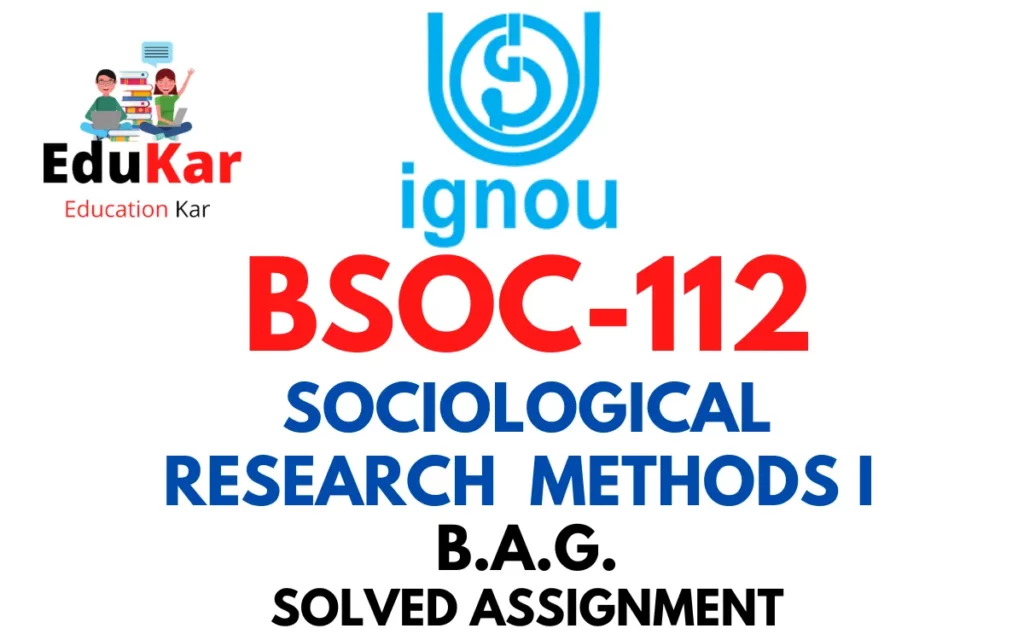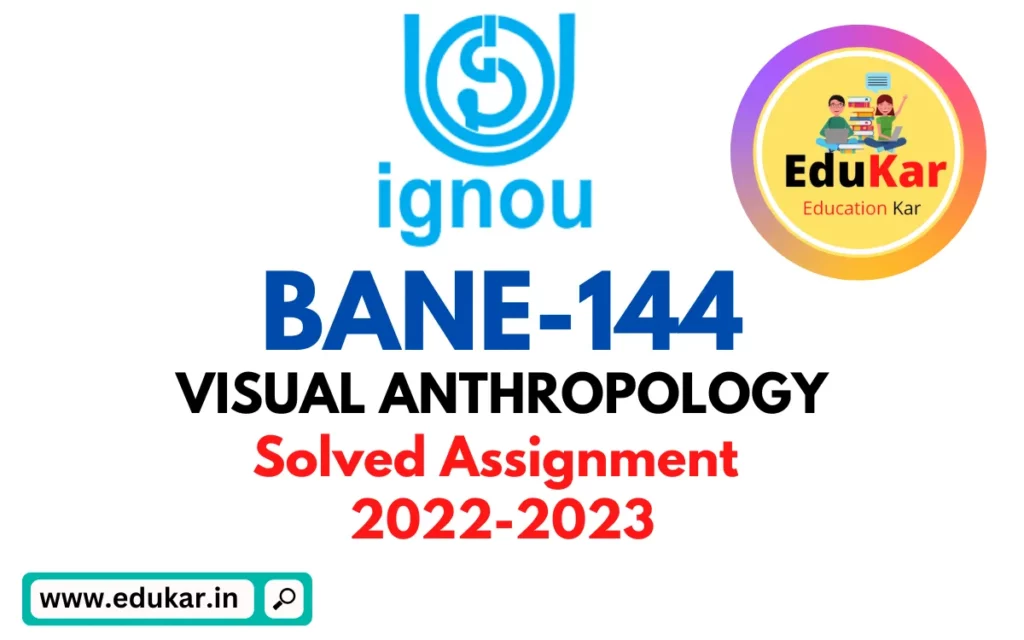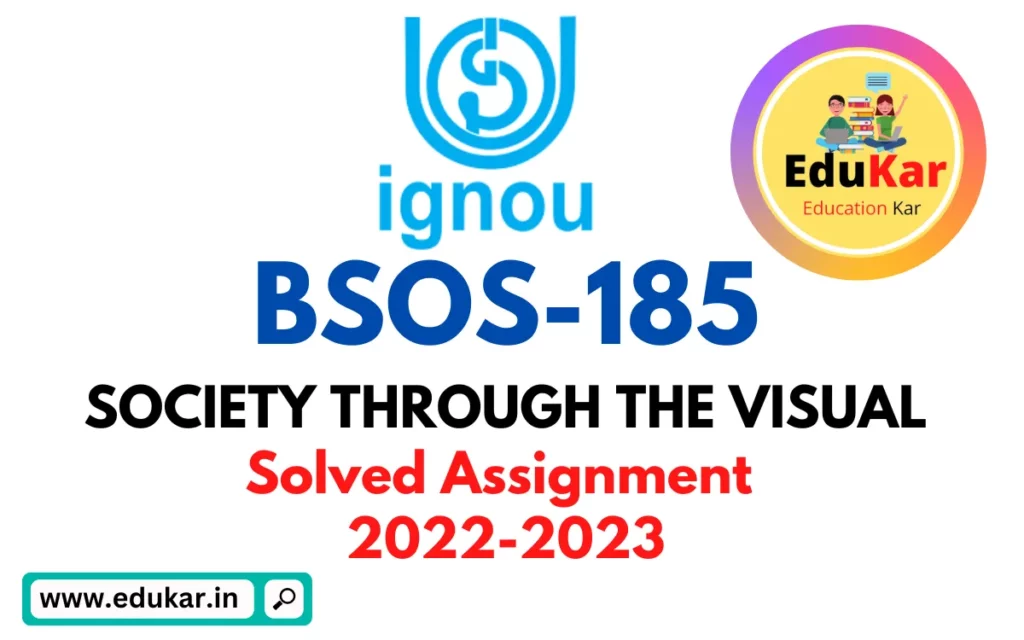Contents
- 1 Assignment – I
- 2 Answer the following in about 500 words each.
- 3 1. What is Ethnography? Discuss in detail types of ethnographies.
- 4 2. Critically examine the position of women in Mukkuvar society.
- 5 Assignment – II
- 6 Answer the following questions in about 250 words each.
- 7 3. Discuss the issues and challenges to ethnography from globalization.
- 8 4. Explain with suitable examples, the Characteristics of a strong leader.
- 9 5. What do you understand by interpretive research?
- 10 Assignment – III
- 11 Answer the following questions in about 100 words each.
- 12 6. What is Online Ethnography?
- 13 7. Name the different phases in which the growth of anthropology in India is divided.
- 14 8. What do you understand by virtual ethnography?
- 15 9. Which are the prominent castes that the Coorgs interact with?
- 16 10. Why do ethnographers develop a rapport and establish relationships with thepeople under study?
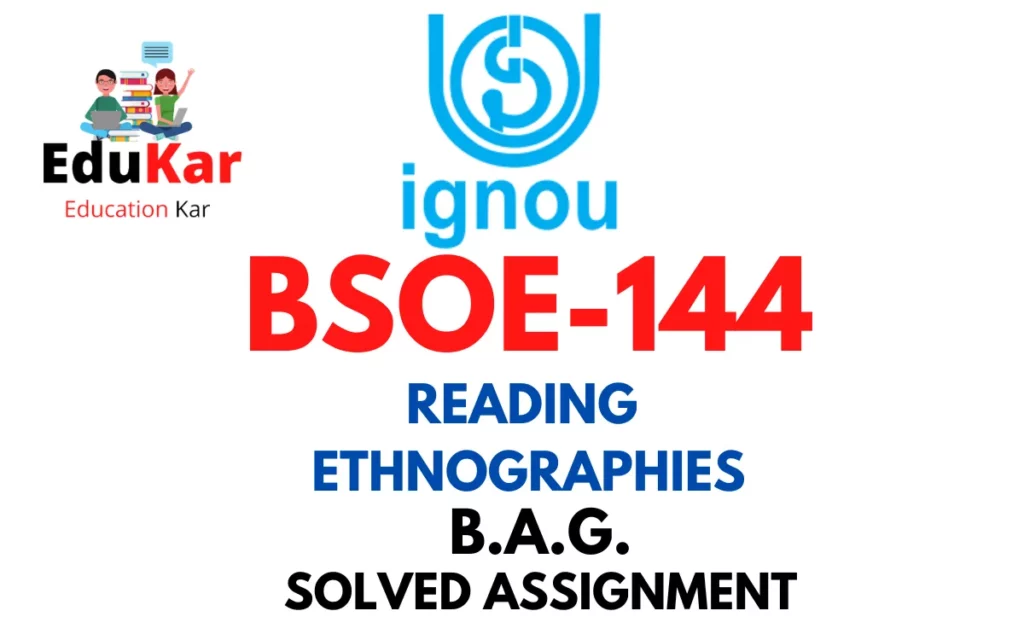
| Title | BSOE-144: IGNOU BAG Solved Assignment 2022-2023 |
| University | IGNOU |
| Degree | Bachelor Degree Programme |
| Course Code | BSOE-144 |
| Course Name | READING ETHNOGRAPHIES |
| Programme Name | Bachelor of Arts (General) |
| Programme Code | BAG |
| Total Marks | 100 |
| Year | 2022-2023 |
| Language | English |
| Assignment Code | ASST /TMA /July 2022 – Jan 2023 |
| Assignment PDF | Click Here |
| Last Date for Submission of Assignment: | For June Examination: 31st April For December Examination: 30th September |
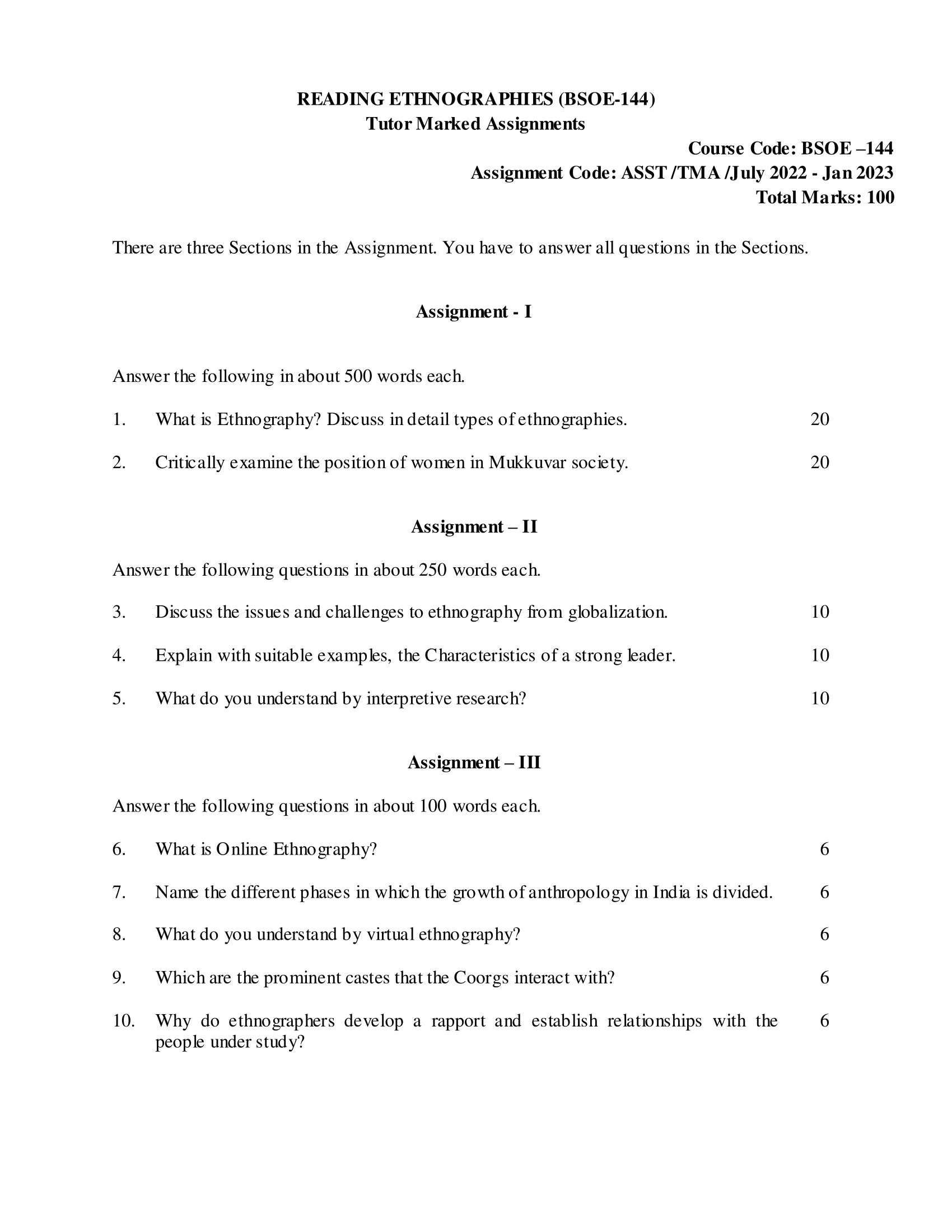
Assignment – I
Answer the following in about 500 words each.
1. What is Ethnography? Discuss in detail types of ethnographies.
Ans: Ethnography is a research methodology used in social sciences, which involves studying people and cultures in their natural environments. The primary goal of ethnography is to understand how people live, their beliefs, values, and practices, and how they make sense of their world. It involves the collection of detailed and comprehensive data through a variety of methods such as observation, interviews, and analysis of documents, artifacts, and texts. Ethnography is an important tool for researchers to gain an in-depth understanding of a culture or community and to explore social phenomena within a particular context.
Types of Ethnographies
- Participant Observation Ethnography: Participant observation is the most commonly used type of ethnography. In this type of ethnography, researchers become part of the culture or community that they are studying, observing and participating in the daily activities of the community. They immerse themselves in the culture, learning the language and customs, and building relationships with the people in the community. Through this process, they are able to gain a deep understanding of the community and the way of life of its members.
- Autoethnography: Autoethnography is a type of ethnography that focuses on the researcher’s personal experiences and reflections as a member of a particular culture or community. In autoethnography, the researcher writes about their own experiences and reflections on their experiences within the community or culture that they are studying. This type of ethnography is often used in interdisciplinary research that seeks to understand how personal experiences shape cultural phenomena.
- Virtual Ethnography: Virtual ethnography is a type of ethnography that uses digital technologies to study online communities and cultures. In virtual ethnography, researchers observe and participate in online communities, such as social media platforms, chat rooms, and forums. This type of ethnography is becoming increasingly important as more people spend time online, and as digital technologies continue to shape our social and cultural practices.
- Life History Ethnography: Life history ethnography is a type of ethnography that focuses on the life stories of individuals within a particular culture or community. Researchers use a variety of methods to collect these life stories, including interviews, observations, and analysis of documents and artifacts. By studying the life stories of individuals within a culture, researchers can gain insight into the culture’s values, beliefs, and practices.
- Comparative Ethnography: Comparative ethnography is a type of ethnography that involves the comparison of two or more cultures or communities. Researchers use this type of ethnography to identify similarities and differences between cultures, and to explore the ways in which different cultures shape human behavior and social practices.
2. Critically examine the position of women in Mukkuvar society.
Ans: The Mukkuvar community is a fishing community found predominantly in the coastal regions of Tamil Nadu, Kerala, and Sri Lanka. Historically, the position of women in Mukkuvar society has been shaped by various social, cultural, and economic factors. This essay will critically examine the position of women in Mukkuvar society and the factors that have influenced it.
Economic Factors: The Mukkuvar community’s traditional occupation is fishing, which has been a male-dominated profession. Women’s role in fishing has been limited to assisting men in preparing the nets and selling the fish. Fishing is a risky and physically demanding occupation that requires the use of boats and other equipment that women may not have had access to. This has contributed to the marginalization of women in the community and their economic dependence on men.
Social Factors: The Mukkuvar community is patriarchal, with men holding the dominant position in the family and society. Women are expected to conform to traditional gender roles, such as taking care of the household and children, and are not encouraged to pursue education or employment opportunities. The community’s strict rules and customs often limit women’s mobility and freedom of expression.
Cultural Factors: The Mukkuvar community has a rich cultural heritage, which includes various customs and rituals that often exclude women. For example, women are not allowed to participate in the annual Kadalpooja festival, which is an important event in the community. Women’s exclusion from these cultural events reinforces the idea that they are inferior to men and reinforces gender inequality.
However, there are also positive developments regarding the position of women in Mukkuvar society. There has been a gradual change in attitudes towards women, particularly among the younger generation. There is an increasing awareness that women’s education and employment are important for the development of the community. Women are now able to participate in decision-making processes and occupy leadership positions in the community. Additionally, government policies and programs that promote gender equality have also played a role in improving the position of women in Mukkuvar society.
Assignment – II
Answer the following questions in about 250 words each.
3. Discuss the issues and challenges to ethnography from globalization.
Ans: Ethnography, as a research method, involves in-depth study and understanding of social groups, their behavior, culture, and practices. The challenges that ethnography faces from globalization are many, and they impact the way research is conducted and the interpretation of data.
One of the primary challenges to ethnography from globalization is the increasing diversity of social groups. As globalization has brought people from different cultures and backgrounds together, the boundaries between groups have blurred, making it difficult to define and study them. In addition, global interactions have led to the emergence of new social groups and identities, which are often not well understood or studied. Ethnographers may find it difficult to understand and represent these new groups and their identities accurately.
Another challenge that ethnography faces from globalization is the changing nature of social relations. Globalization has led to the emergence of new social relations that are not confined to geographical boundaries. These new social relations are often based on global networks and technological platforms, making it difficult for ethnographers to access and study them. In addition, globalization has led to the emergence of new forms of inequality and power dynamics, which are often not visible to the ethnographer.
Finally, the impact of globalization on culture and identity is another challenge to ethnography. As global interactions have led to the spread of popular culture, norms, and values, local cultures are being transformed or disappearing altogether. This transformation can make it difficult for ethnographers to understand and represent the cultural practices and traditions of a community accurately.
4. Explain with suitable examples, the Characteristics of a strong leader.
Ans: A strong leader is someone who is able to inspire and motivate their team to achieve a common goal. The following are some of the key characteristics of a strong leader:
- Visionary: A strong leader has a clear vision of the future and is able to communicate it to their team. They are able to see beyond the present and inspire their team to work towards a future goal. For example, Elon Musk, the CEO of Tesla and SpaceX, has a vision of colonizing Mars and is able to inspire his team to work towards achieving that goal.
- Decisive: A strong leader is able to make difficult decisions quickly and confidently. They are able to weigh the pros and cons of a situation and make a decision that is in the best interest of their team. For example, during the COVID-19 pandemic, New Zealand’s Prime Minister Jacinda Ardern made decisive decisions to impose strict lockdowns to protect the health of the citizens.
- Empathetic: A strong leader is able to understand the needs and concerns of their team and respond to them with empathy. They are able to create a safe and supportive work environment where team members feel valued and respected. For example, Microsoft’s CEO Satya Nadella emphasizes the importance of empathy in leadership and encourages his team to prioritize it.
- Strategic: A strong leader is able to think strategically and plan for the long-term success of their organization. They are able to anticipate future challenges and develop strategies to overcome them. For example, Jeff Bezos, the founder and former CEO of Amazon, developed a long-term strategy for the company’s success and was able to grow it into one of the world’s most successful companies.
- Authentic: A strong leader is true to themselves and their values. They are transparent and honest with their team and are not afraid to show vulnerability. For example, Brene Brown, a researcher and author on vulnerability, emphasizes the importance of authenticity in leadership and its ability to build trust with team members.
5. What do you understand by interpretive research?
Ans: Interpretive research is a qualitative research method that focuses on understanding and interpreting people’s experiences and perspectives. This type of research is concerned with exploring the meanings that individuals and groups ascribe to their experiences and how these meanings shape their behavior, attitudes, and beliefs.
Interpretive research is often used in the social sciences, particularly in fields such as sociology, anthropology, and psychology. Researchers who use this approach often use methods such as in-depth interviews, participant observation, and focus groups to gather data. They then use various techniques such as content analysis, thematic analysis, and narrative analysis to interpret the data and gain insights into the participants’ experiences.
One of the key characteristics of interpretive research is that it is subjective and value-laden. Researchers who use this approach acknowledge that their own beliefs, values, and experiences shape their interpretation of the data. As a result, they often use reflexivity, which involves reflecting on their own biases and assumptions throughout the research process, to ensure that their interpretations are as objective as possible.
Interpretive research is useful for exploring complex social phenomena that are difficult to measure or quantify, such as the experiences of marginalized groups, the influence of culture on behavior, or the impact of social norms on decision-making. It is particularly useful when researchers seek to understand the subjective experiences of individuals, groups, or communities.
Assignment – III
Answer the following questions in about 100 words each.
6. What is Online Ethnography?
Ans: Online ethnography is a type of ethnographic research that focuses on the study of online communities and cultures. It involves the use of digital technologies such as social media platforms, chat rooms, forums, and websites to observe and participate in online communities. Online ethnography is becoming increasingly important as more people spend time online and as digital technologies continue to shape our social and cultural practices. The methods used in online ethnography are similar to those used in traditional ethnography, such as participant observation, interviews, and analysis of documents and artifacts, but are adapted to the online environment.
7. Name the different phases in which the growth of anthropology in India is divided.
Ans: The growth of anthropology in India can be divided into several phases, which are as follows:
- Colonial phase (late 18th century to mid-20th century): This phase was characterized by the British colonial administration’s interest in Indian society and culture. Anthropologists during this period focused on documenting the customs and traditions of Indian society, with a view to understanding and controlling it.
- Nationalist phase (mid-20th century to late 20th century): This phase was characterized by a growing sense of nationalism in India, which led to the development of indigenous perspectives on anthropology. Anthropologists during this period focused on studying Indian society and culture from an insider’s perspective, and on challenging colonial stereotypes and biases.
- Modern phase (late 20th century to present): This phase is characterized by the emergence of new themes and approaches in anthropology. Anthropologists during this period have focused on issues such as globalization, gender, health, and the environment. They have also developed new methods and techniques, such as participatory research and collaborative ethnography, to engage with communities and to address contemporary social and political issues.
8. What do you understand by virtual ethnography?
Ans: Virtual ethnography, also known as cyber-ethnography or netnography, is a type of ethnographic research that focuses on the study of online communities and cultures. It involves using digital technologies such as the internet, social media platforms, and other online communication tools to observe and participate in online communities.
Virtual ethnography can be used to study a variety of online communities, including forums, chat rooms, gaming communities, social media platforms, and other online spaces where people interact and engage with each other. This type of research involves using a range of methods, such as participant observation, online interviews, and analysis of digital artifacts, to gain an understanding of the culture, practices, and values of the online community.
Virtual ethnography has become increasingly important as digital technologies have become an integral part of our social and cultural practices. It allows researchers to explore the unique features of online communities, such as the use of anonymity, the creation of online personas, and the use of digital media to communicate and express identity. Virtual ethnography can also be used to study the impact of digital technologies on social and cultural practices, and to explore the potential of online communities to create new forms of social and political engagement.
9. Which are the prominent castes that the Coorgs interact with?
Ans: The Coorgs, who are an indigenous community in the Kodagu district of Karnataka, India, interact with a number of different castes and communities in the region. Some of the prominent castes that the Coorgs interact with include:
- Gowdas: The Gowdas are a prominent agricultural community in Karnataka, and they form a significant part of the population in the Kodagu district. The Coorgs and the Gowdas have historically had close ties, as they share a common culture and way of life.
- Kurubas: The Kurubas are a pastoral community in Karnataka, and they form a significant part of the population in the Kodagu district. The Coorgs and the Kurubas have traditionally had close ties, as the Coorgs often hired Kuruba shepherds to look after their cattle.
- Brahmins: The Brahmins are a priestly caste in India, and they form a significant part of the population in the Kodagu district. The Coorgs have historically had close ties with the Brahmins, as they often served as advisors to the Coorg rulers.
- Muslims: The Muslim community is a significant minority in the Kodagu district, and they have historically had close ties with the Coorgs. The Coorgs and the Muslims have shared a common culture and way of life, and have often worked together in the fields and on other projects.
- Lingayats: The Lingayats are a religious community in Karnataka, and they form a significant part of the population in the Kodagu district. The Coorgs and the Lingayats have traditionally had close ties, as they share a common culture and way of life.
10. Why do ethnographers develop a rapport and establish relationships with the
people under study?
Ans: Ethnographers develop a rapport and establish relationships with the people under study to gain trust and access to their cultural practices, beliefs, and values. Developing a rapport with the community allows ethnographers to gain an insider perspective on their way of life, which is essential for conducting effective ethnographic research. By building relationships with the community, ethnographers are able to understand the cultural context of their research, which helps them to interpret the data they collect. Additionally, building a rapport with participants can help to ensure that the research process is ethical and respectful. Ethnographers need to build trust with participants to ensure that their research is accurate, ethical, and effective.
How to Download BSOE-144 Solved Assignment?
You can download it from the www.edukar.in, they have a big database for all the IGNOU solved assignments.
Is the BSOE-144 Solved Assignment Free?
Yes this is absolutely free to download the solved assignment from www.edukar.in
What is the last submission date for BSOE-144 Solved Assignment?
For June Examination: 31st April, For December Examination: 30th October



